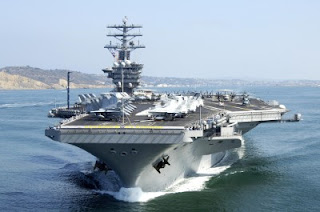Aircraft Carriers: R.I.P?
Two detailed arguments on the end of the aircraft carrier emerged earlier this month. The first, which has already received notable attention in the naval blogosphere, comes from Captain Jerry Hendrix in the form of the first Center for a New American Security (CNAS) “Disruptive Defense” paper. CNAS’s Disruptive Defense series seeks to provide analysts an opportunity to “present hard-hitting arguments” on controversial U.S. defense issues.
Hendrix argues that the modern American nuclear aircraft carrier (CVN) is, in cost-effectiveness terms, unequal to the task of managing the proliferation of anti-access technologies, particularly China’s DF-21D Anti-ship ballistic missile (ASBM).
This argument has not gone unchallenged. As Bryan McGrath argues over at Information Dissemination, a straight comparison between the costs of a CVN and of 1,227 DF-21s is surely misleading; both weapons require support systems not included in that cost, and the carrier is considerably more flexible in usage than the ballistic missile.
Moreover, many of the key problems identified by Hendrix involve decisions about the air group rather than about the platform itself. Carriers need planes, and any assessment of the cost of a carrier requires an analysis of the price and capabilities of its aircraft. At the same time, carriers tend not to be bound to a single specific air group configuration, and over the lifespan of the platform will be expected to employ many different aircraft.
The blogger Sir Humphrey presents a broader challenge to the aircraft carrier, arguing that it is in decline across the globe. Spain has given up its lone carrier in preference for a (somewhat larger) amphibious multi-purpose ship, the Principe de Asturias. Italy may soon do the same and the future of France and Brazil’s carrier fleets are increasingly in doubt.
I’m sympathetic with parts of this argument, as it seems clear that states are more frequently opting for multi-purpose aircraft carrying ships that can conduct amphibious, command, and relief missions in addition to serving as platforms for high-intensity air combat.
The key transition, however, involves less a decision to forego carriers than the lack of an affordable successor to the Harrier jump jet, which has long served as the staple of naval air forces unable to operate CATOBAR (Catapult Assisted Take Off But Arrested Recovery) aircraft. The last Harrier II was delivered in 2003, making it not particularly old for a modern jet airframe, but the maintenance and training requirements exceed the capabilities and resources of many small and medium size navies.
An affordable, user-friendly successor to the Harrier II might find numerous international customers, although perhaps not enough demand to justify design costs. Perhaps UAC could devote some attention to developing a useful successor to the Yak-38? However, during the Libya conflict the French and British navies ameliorated this gap by launching attack helicopters from amphibious assault ships, a project that emphasized the flexibility of the flat deck aircraft carrying ship.
I suspect that we will continue to see navies devoting resources to multi-purpose flat-deck aircraft carrying warships. Put simply, as long as states continue to see utility in such ships, they’ll continue to build them. Larger ships with dedicated equipment will carry more and better aircraft. The largest ships, operated by the largest states, will carry an array of exceedingly advanced aircraft, both manned and unmanned.
At the same time, the constitution of a carrier air group will always be an imperfect fit with the tasks of the day, because development of the air group generally takes place long before the specifics of future conflict are known. And this fact underscores the utility of aircraft carriers.
Any air group (whether consisting of F-35s, F/A-18s, Yak-38s, A-6s, or Sea Hawk helicopters) represents a best guess at the demands of future conflict, mediated through the lenses of bureaucracy and the defense industrial base. Many of the assumptions behind these decisions can and often do turn out to be incorrect. The carrier’s primary virtue is therefore its flexibility and adaptability to different circumstances, not in its unique capacity to solve specific problems.

camisetas futbol baratas
ReplyDeletecoach handbags outlet
lebron shoes
tory burch sale
air max 90
fred perry polo shirts
uggs outlet
ugg boots
coach outlet store
lacoste shirts
michael kors outlet online
michael kors factory store
ferragamo outlet
tiffany and co
canada goose jackets
tods outlet
vans shoes
chanel outlet store
chanel handbags outlet
0114minko